|
The highway south of the Broome turn-off skirts around the eastern edge of Roebuck Bay. Riding was difficult for the first part of the day because of the regular easterly wind of the north Australian dry season. Karen and I rode for a couple of hours to a morning tea stop in a parking bay at thirty five kilometres before the highway swung around to the south-west and the wind began to help.
A seventeen kilometres per hour average rose to almost twenty by the time we had lunch in another barren parking bay at eighty kilometres. Midway along the last fifteen kilometres of highway before the Barn Hill turn-off, a motorist flagged us down.
"Would you like a lovely, ice-cold drink of water?" he asked.
"No thanks, we've just had plenty of water with lunch, but thanks for the offer," I said, but secretly I was also thinking "You bastard!" because when he made the offer I was certain that he was about to say "a lovely, ice-cold drink of beer."
A huge tyre embedded in the sand and painted white told us we had arrived at the track into Barn Hill Station. We dialled the numbers we had been given into the combination lock that sealed the front gate, pushed our bikes through and locked the gate behind us. Ahead of us was the worst dirt road we would ever encounter.
The homestead of Barn Hill Station is nestled just behind the coastal dunes of Roebuck Bay about ten kilometres from the highway. It is reached via a dead straight track made from the red sand and bulldust of the Great Sandy Desert. Wheel-grabbing drifts a half metre or more deep over much of its length made cycling virtually impossible, and even pushing the bikes was bloody difficult. Some sections were solid but these were rare and rough, their rutted and corrugated surfaces soon disappearing under the sand. The only time the corrugations went missing was when the track dissolved into large, bottomless bulldust holes.
Normally, Karen and I would not have attempted to travel along a track as bad as this one, but we had no alternative. Barn Hill had water, and ours was fast running out. To make matters worse, the track runs due west, straight into the heat and glare of the late afternoon sun. After ninety five kilometres of riding on legs already weakened by lengthy spells away from the bikes, this was the last thing we needed. Those ten kilometres eventually took us almost two hours, and were so tough that Karen was in tears for much of it.
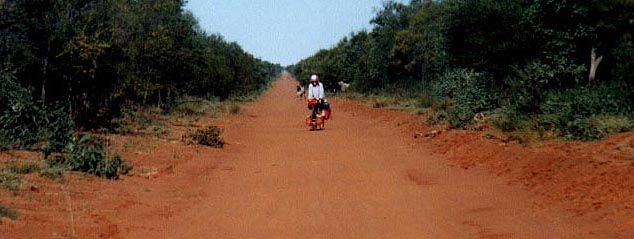
The road to Barn Hill
Eventually we noticed a prominent hill rising from the flatness of the scrub. We figured this was the feature which had given Barn Hill its name, and we knew we were almost there. The track turned for the first time and swung down to a homestead. Karen had never been so happy to see a house in all her life. She composed herself and we knocked on the door. A woman came out and greeted us, taking our money for a tent site and pointing us down a shortcut through the bush to the camping area.
"There's a guy down there called Peter who runs the camping area. He will probably be able to find a bit of room somewhere to slot you in." We thought we must have been hearing things due to the rigours of the day. Because of the remoteness of the property, the locked gate requiring pre-booking of access, and the wretched state of the horrible track which had to be negotiated to get there, Karen and I believed we would be the only people at Barn Hill that night. When we pushed our bikes along the shortcut track and arrived at the camping area, we knew we were hallucinating. There were over forty caravans there! What was going on? Had we stumbled into some sort of cult thing?
We found the guy we had to find, and he found us a spot for our tent. He told us that a communal barbecue was held every Wednesday night and we were welcome to come along. After setting up our tent we headed towards a large, open fire at the edge of the camping area where thirty or forty people were sitting around in a circle, having a few drinks and cooking dinner on the fire and an adjacent barbecue. Peter and Merle introduced themselves, and got us a couple of spare chairs to sit on. They explained what was going on as we ate snacks of freshly cooked fish pieces which were being passed around the circle.
The only cult activity being practised at Barn Hill was fishing. Almost everybody there, with the exception of Karen and myself, were fishermen. Most came from the south-west of Western Australia to stay at Barn Hill for a month or more, simply because the fishing in the area was outstanding. Sites were booked a year or more in advance, and during the Dry the place was almost always full. Many people came back year after year and a little community of regulars had formed. Barn Hill was just like a little town.
Karen and I soon retired to cook dinner. We ate our Mussaman curry of rice and lentils under a star-filled sky and watched the double-flash of the Gantheaume Point lighthouse away to the north-east across the waters of Roebuck Bay. A day and a half earlier we had walked through the shadow of the lighthouse on our way to look for dinosaur footprints, and now, after one hundred and forty kilometres of riding, we could still see the place where we started from!
We did not return to the party by the fire, the exertions of the day having caught up with us. As we drifted off to sleep the sounds of the merry-makers kept us company for a while. Merle had told us that she would be playing her accordion later, another reason why we had not returned to the party, but although we were not there to see her play, we certainly heard her. The last thing I remember of that day was a bawdy rendition of Old McDonald Had A Farm.
"Old McDonald had a farm,
E-I-E-I-O,
And on that farm he had a camel,
E-I-E-I-O,
with a hump-hump here and a hump-hump there,
here a hump,
there a hump,
everywhere a hump-hump."
In the morning Karen could not face the ride back out along the sand track, so we decided to stay at Barn Hill for a day and hopefully arrange a lift back out to the highway. After brekkie we walked down the beach for one and a half kilometres to a low, rocky headland where we climbed and photographed some impressive rock formations. They were better than those at Gantheaume Point just across the bay in Broome. The weather was hot enough for a swim, but after hearing a recent eye-witness account of a five-metre shark tearing a live dugong in half, Karen and I decided to give the swim a big miss. Back at the camping ground Tom and Molly showed us the honesty box vegetable stall, and we bought fresh pumpkin and beans to go with a wad of frozen fish they gave us for dinner. While Karen made lunch in a backpacker kitchen near our tent, I sewed up the top eight inches of the inner tent zipper as it had come apart completely.
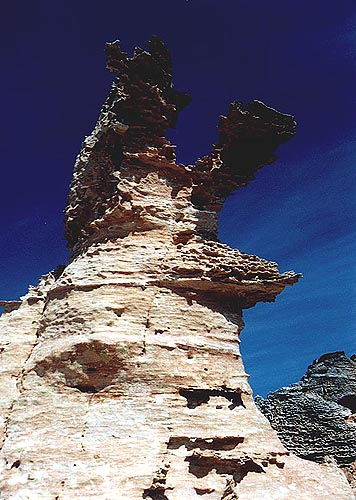
Typical rock formation at Barn Hill
In the middle of the afternoon we went for extended walk to the top of Barn Hill, an awesome climb of at least twenty metres! We then cut across to the beach to the north where we found more spectacular rock formations which almost devoured an entire roll of film. I just had enough left for a few shots of a good sunset over the water.
After our dinner of fish, pumpkin and beans, Karen and I went to a bingo night! This was a regular event on the Barn Hill social calendar, and it was held in Jack's Shack, a chalet cum beach house cum backpacker hut on the other side of the camping ground. Five dollars and two hours later, with no major wins to our name, the bingo finished. We spoke to Rick, the owner of Barn Hill station, who told us that he would be able to give us a lift out to the highway the next morning, then retired to our tent after lovely hot showers.
We rose at 6am to pack. A woman named Bev, whom we had nodded and smiled at but not spoken with, approached us as we were about to leave and gave us a couple of pieces of frozen fish to take with us for dinner. The generosity of the people at Barn Hill was amazing.
At 7:30am Karen and I pushed Elle and Mel up to the main house and met Rick. It took all three of us to lift our heavily laden bikes onto the back of a large, flat-bed truck. We propped Mel against the bars behind the cab, and then snuggled Elle against him, nose to tail. Karen and I stood behind the bikes, each of us with a foot on the outside of the front and back tyres to prevent the bikes from rolling left or right. Our legs were pushed up against the front and back panniers to stop the bikes moving backwards, and we reached over them to grip the top bar behind the cab.
Once the truck began to move, the cold, desert air cut through our thin clothing like a knife. Our noses started to run. Tears streamed down our faces, but we could not let go of the bar to wipe them away. The track was just as bumpy for the truck as it had been for the bikes, and Karen and I were forced to hang on for dear life. With every bump the bikes would jolt a few millimetres backwards, and despite our efforts to keep them upright, we feared they would fall. Luckily, we had to stop a few times to open and close gates, and we used this time to re-adjust our positions. We covered the ten kilometres out to the highway in only ten minutes, a far cry from the gut wrenching two hours we had taken two days previously. We said goodbye to Rick after thanking him for the lift, and were surprised to see him turn straight around and return to Barn Hill. We had thought he was on his way into Broome for supplies and was dropping us off on his way through, but in actual fact he had made the twenty kilometre round trip just for us!
Karen and I began riding at 8am with the wind not really helping too much, but not hurting us either. The terrain was a very gently undulating, flattish scrub composed of wattles and holly-leafed grevilleas. We soon came to a roadside vegetable stall outside the entrance to Shamrock Station. A female Scottish backpacker sold us some tomatoes, and explained that the station grew their own vegetables and also supplied the stall at Barn Hill.
After forty three kilometres we stopped for morning tea in shade at the side of the road, then carried on to a rest area called Stanley at eighty five kilometres, our only other stop being to pick up our eight litres of water perfectly dropped at the "PH 410" sign by the Kiwis we had met at the Roebuck roadhouse. We had lunch, then decided that Stanley would be as good a place to stay as any. We could have travelled further but with no possibility of reaching the Sandfire Roadhouse in the afternoon, further riding seemed pointless.
The rest area was good by Western Australia standards, with a sheltered table and chairs and a drop toilet, but of course, no water. We have no idea what Stanley had been in a former life, but it contained large areas of concrete which must once have been the floors of some kind of building. Embedded within some of these were metal tracks, either for sliding doors or some kind of vehicle.
A lone caravan was occupying the rest area, a shirtless man of generous proportions drinking beer and sunning himself on a fold-up chair outside. Karen and I went over to speak to him, primarily to find out if he was staying the night, and whether he would be potentially dangerous if he did. After all, sitting in the sun drinking beer is a normal thing to do in the city, especially with a football game in front of you, but doing it in the middle of the Great Sandy Desert a hundred kilometres from the nearest bit of civilisation is a little bit strange. We learned that the guy was a bit of a worry, but he told us that twenty caravans had stayed at the rest area the previous night, so hopefully there would be safety in numbers.
After setting up the tent Karen and I went for a walk around the area in search of birds. We saw lots of Red-winged Parrots and crested Pigeons, and then something else which we did not recognise and could not immediately find in our bird book. It took us quite a while to realise that we were looking at a Rufous Songlark, another new bird for us. We relaxed under the shelter all arvo and chatted to a couple of couples as they came and went. Karen and I were beginning to get concerned that we would be alone in the rest area all night with the fat beer drinker with the good tan, but late in the day two caravans pulled in and a quick conversation determined they would be in residence until the morning. Karen managed another culinary miracle for dinner - curried fish and capsicum on a bed of pasta and beans.
The clear blue sky of the day stayed just as clear overnight, causing the temperature to plummet. The easterly wind which had died during the afternoon sprung up again around midnight and was still blowing at dawn. We were warm in the tent, but when we went outside it was bloody cold - about five degrees. Riding warmed us up, with both the wind and the wind-chill disappearing as we matched the speed of the tailwind.
Despite the impression given by its name, the Great Sandy Desert does not resemble the classic yellow, sandy deserts like the Sahara. It is a vast plain of red soil and spinifex, and was surprisingly lush when we rode through it. Wattles and grevilleas were everywhere, but these soon gave way to lower scrubby rubbish as we cycled onward. The terrain was flat and uninspiring but the monotony was relieved just prior to morning tea at forty kilometres when we spotted a few wild camels. An hour later we met a Scottish cyclist who had obviously not done his homework. Anti-clockwise is the way to go around Australia, and the Scot had been pushing into headwinds for over a thousand kilometres. I would have given up and turned around, but the Scots are a very dour and determined breed.
Karen and I lunched in a parking bay at eighty five kilometres, and shortly afterwards came across the first of the samphire flats which give the Sandfire roadhouse its bastardised name. Birds were everywhere - black-winged stilts, marsh terns, gull-billed terns, grey teals, grebes, pelicans and straw-necked ibises. The last five kilometres for the day were almost due west with the wind directly behind us. We only had to keep the pedals turning over to keep our speed above twenty five kilometres per hour. As we pulled into the roadhouse at 3pm, Karen and I were still talking about the major highlight of the day which we had just passed - the mighty Mt Phire, which towered ninety two metres above sea level!
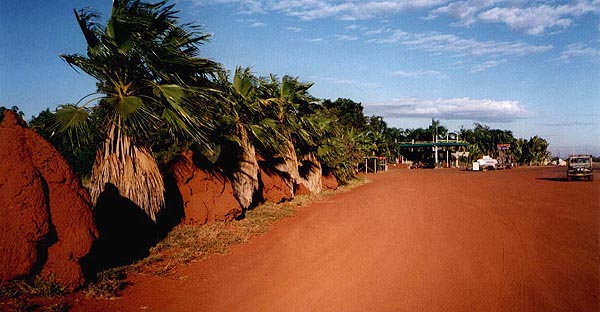
The Sandfire roadhouse
After a discussion with the roadhouse management, Karen scored two free cups of coffee for us. We could not understand their problem - the sign said "Free coffee for driver" and Karen and I were both drivers in charge of vehicles. The roadhouse was the typical outback oasis. We hand-fed a yellow throated miner, avoided all the geese and peacocks and their droppings, and set up our tent in the adjacent camping area. Dinner was hamburgers and chips and a bottle of Lift in the dining room, which sported a television. The weather report predicted strong easterlies for the following day, which was good for us but bad news for the Scot we had passed earlier in the day. As luck would have it, the news was followed by an Aussie Rules match between the Fremantle Dockers and Port Adelaide, and I watched it, naturally.
All the stories you hear about nights in the desert being cold are absolutely correct. While I packed up the tent in the morning, Karen cooked our breakfast on a table in the sun outside the front of the roadhouse. Our metho bottle was almost empty, and the roadhouse had none either, so Karen, with her typical no-harm-in-trying attitude, asked the girl behind the counter for some boiling water for our coffee. Unbelievably, we got some - from their urn near the front door where they sold tea and coffee at one dollar and thirty cents a time!
We hit the road at 7:45am. Two hours later at forty five kilometres we reached the turn-off to Eighty Mile Beach. Because of our low food and metho stocks, we decided to give the beach a miss. We had a good wind behind us and the track looked really bad too - we did not want a reprise of the Barn Hill road fiasco.
Karen had been complaining that she did not seem to be travelling well, but it was not until a scraping noise began coming from her front wheel that she realised the tyre pressure was way down. I checked the tube and found that it had been patched six times before. It was probably just as original as Karen's front tyre. After changing the tube we were soon on our way again, with Karen's performance noticeably improved. In the meantime I was having my own problems. The chain which I had attempted to replace in Derby and subsequently forgotten all about, had begun making funny noises at twenty kilometres and by forty kilometres it was jumping from sprocket to sprocket all by itself. We took a morning tea break at fifty three kilometres where I drowned the chain in CRC lubricant. It worked okay afterwards, but it would definitely need replacing as soon as we got to Port Hedland.
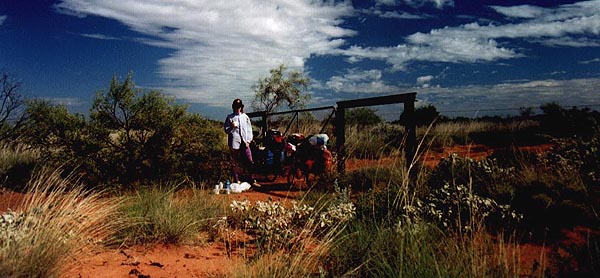
Morning Tea
The wind was perfect, right behind us and reasonably strong. We rode through flattish undulations, at times travelling at thirty kilometres per hour for extended periods. Our average speed suffered during the middle part of the day when the undulations became shorter and steeper as the highway and the Great Sandy Desert neared the coast again. Even with our tyre and chain problems, Karen and I still managed a very respectable one hundred kilometres time of just over four hours. Shortly after a stretch break just prior to lunch, Karen spotted a new bird - pied Honeyeater. We lunched at one hundred and ten kilometres in a bit of shade at the side of the road, and shortly after resuming riding we hit the five hour mark for the day having travelled one hundred and twenty one point seven kilometres - probably a record.
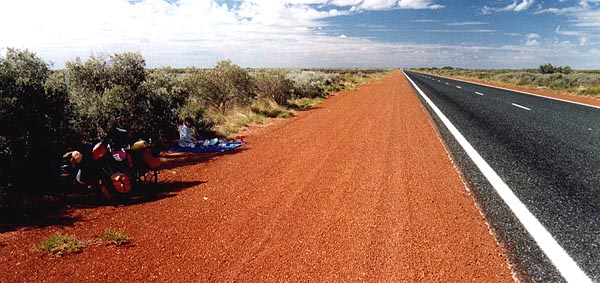
Lunch at the side of the road
The countryside flattened out after lunch, but the wind abated so our speed remained fairly constant. Just before we reached the Pardoo roadhouse, I spotted a dead bird beside the road which I was fairly sure we had not recorded before. I rode on for a couple of hundred metres before telling Karen about it, then talked her into going back for another look. This little diversion actually killed two birds with one stone - if you will pardon the pun. Not only did we score a new tick with the black Honeyeater, but the extra four hundred metres pushed our distance up to one hundred and thirty nine kilometres, the furthest we would ever travel in a day. We had spent five hours and forty eight minutes in the saddle and average twenty four kilometres per hour - an excellent day.
An Australian Hobby greeted our arrival at the roadhouse. This was the first time that Karen had seen one. She had continued riding when I had stopped to get out my binoculars and make a positive sighting at Berridale in the Snowy Mountains of southern New South Wales. That had been a whole continent away in a completely different environment. The book says the bird can be seen anywhere in Australia. The book is right.
Karen performed yet another miracle with lentils, rice, curry and coconut milk for dinner, then we retired to the light and warmth of the roadhouse for celebratory ice-creams. Another couple staying at the roadhouse overnight had rented a video and were watching it on the television in the café. Karen and I sat quietly in the background and watched it too - White Squall with Jeff Bridges. It was not great, but beggars cannot be choosers in the middle of a desert.
East south-easterly crosswinds dogged us for the first fifty kilometres the next morning. Port Hedland was just about reachable, although it would require another record day. Unfortunately, Karen's body chose this moment to realise yet again that she had not become pregnant during the past month, and she was suffering her usual nausea and cramping. Another record day was no longer on the cards. Karen soldiered on through the basically flat, wattle covered terrain. The riding became easier when the road swung around to the west through red hills of iron ore near the abandoned mining town of Goldsworthy. Even the passing flocks of budgies and the occasional kestrels and falcons could not distract Karen from her pain, so when we reached the De Grey River just after midday and found a lovely tent site overlooking the water, we knew we had finished riding for the day. Seventy two kilometres had been covered, and Port Hedland was eighty kilometres away - a nice split.
Flocks of Corellas watched us set up our tent on thick, soft grass on top of the river bank. The De Grey was the first river we had crossed in over seven hundred kilometres! It not only signalled the end of the Great Sandy Desert, but also marked the start of a long series of riverside camping spots.
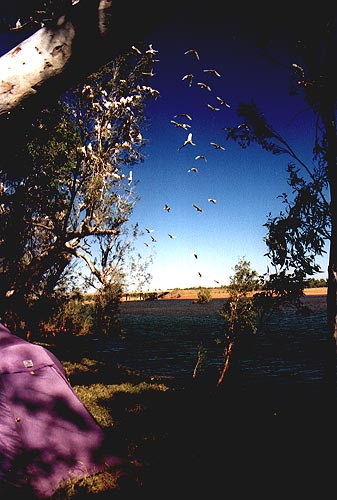
Our De Grey River campsite with Corellas
There were quite a few caravans staying overnight in the free camp site by the river. Karen and I spoke with Ken and Betty from Portland and a few other campers as well, all of whom intended staying on the De Grey for a few days. They told us that two other cyclists very similar to us had been camped by the river overnight and had only left this morning. This must have been the couple that Karen and I had been mistaken for in Derby. Karen and I checked our supplies and scraped up enough food to get us by for an extra day, so we decided to spend a day beside the river as well. Why travel when we did not have to, especially when Karen was feeling crook and we had a beautiful tent site overlooking a lovely river?
Karen spent most of the afternoon lying in the shade. We had dinner at a table near Ken's van, and we were grateful for his donation of half a rockmelon for our dessert. During the night we heard the approach of footsteps and the gentle sound of cattle as they munched grass near our tent. We turned on our torches to illuminate the tent so the cows would know where we were and not blunder into us in the dark. It seemed to work - we were still intact in the morning.
We slept in until 7am, had brekkie, then went for a walk down the river. The De Grey would have made an impressive sight during the Wet, but halfway through the Dry it was shallow and barely flowing. Downstream from us it became a deeper rivulet meandering through a wide, stony channel. The stones which made up the bed of the De Grey were fascinating, a rich assortment of colours and patterns. Karen and I had steadfastly avoided collecting rocks in the past, but these were so different that I could not help myself. Stone after stone was added to my day pack.
At one point Karen stopped for a wee break. I continued to stroll along the river, searching for more stones amongst the stumps and fallen trees along the bank. After I had walked about one hundred metres, I stopped so Karen could catch up. I waited, and waited, and then I waited some more, but Karen did not show. I slowly walked back to where I had left her, but she was not there either. I was certain she had not walked past me along the river, so I made my way back towards our campsite. Sure enough, when I got back Karen was sitting there having morning tea. Recriminations followed. Why did you wander off and leave me alone? Why didn't you follow me down the river? In the end I blamed Karen's condition and simply shut up.
We therefore had an early morning tea with choc-chip bikkies and then walked up the river to cross over at the bridge. A box-like construction at its far end had a truck from the Waters and Rivers Department of Western Australia parked next to it. Karen and I took a look inside the open door of the blockhouse and found a department worker monitoring the river height. He told us that the river was only three hundred millimetres above its no flow level. He gave us a brief tour of the monitoring station and also gave us a history of recent water levels. His most interesting news, however, was that only one saltwater croc had ever been sighted this far south, and then only after the Fitzroy River had flooded even more than normal and flushed a number of salties out to sea. We were effectively out of croc territory, but having lived with their constant threat for a couple of months, Karen and I would still feel apprehensive every time we swam, almost until we had reached Perth.
We walked down the opposite side of river for almost a kilometre and crossed at a wide race where the water was only shin deep. A pair of black-fronted plovers caught our attention, and with them was a tiny, fluffy chick. When we approached, the adults made a great hubbub and tried to lure us away from their baby who was now lying motionless pretending to be a rock. When Karen and I walked up to it and gave it a little pat, the chick did not move. We moved away to watch from a distance. The adults flew over the top of the chick a few times to ensure it was still okay, but they would not return to the chick until we moved out of sight completely.
During the afternoon Karen did some sewing repairs on her handlebar bag which was coming apart, and I did the same for my riding gloves. We read, relaxed, and talked to Ken and Betty about travel in the Grampians and other recommended places, picking up some useful information for later in the trip. They also told us about one of the other campsite residents, and in this case, resident was a very accurate description. Karen and I had met many caravanners from the southern states who migrated north for the winter. Most of these would move around from place to place, sometimes spending as long as two months in one location before moving on or going home, but lately we had discovered that some winter migrants travel to a single location and stay there for six months or more. Many of the people at Barn Hill fit this description. A couple at Mary Pool were semi-permanent residents as well. But the shining example of the breed was located here at the De Grey River.
River campsites have always been prime overnight locations for travellers. Their facilities are few - a garbage bin or two, maybe a table, rarely a toilet. Councils and government departments have found that it is cheaper to provide roads and rubbish removal for these sites than it is to attempt preventative measures to stop people from accessing them. River campsites have become a feature and a tradition of travel in Australia. The people we met at the De Grey, however, had taken this tradition to new heights. They had been there for months, and had altered their immediate environment to suit themselves. They had cut steps down to the water in the dirt of the river bank, and regularly made good catches of fish. A hessian bush-shower hung from an overhanging tree. Beer was brewing in a vat out the back. They were even growing beans and tomatoes in a garden bed at the side of their van! And whenever supplies grew low, the supermarkets of Port Hedland were less than an hour away down the highway. They were on a pension, had no accommodation costs, loved fishing, fresh air and meeting people. What a life!
Karen cooked another rice and lentil Mussaman curry for dinner as we sat around a communal fire with three other caravanning couples. Ken and Betty supplied us with dessert yet again - pears and custard! We were all amused by one bloke who obviously had more money than sense. With no prior experience of travelling he had bought a huge, brand-new caravan, filled it with every modern convenience under the sun and taken off for the great outdoors. He was not getting away from it all, because he had brought everything with him! His brand new generator was puttering away in the background, providing unnecessary light for the rest of us who would have been quite happy with only the firelight and some silence. Our amusement came from his frantic attempts to keep the generator operating. It would cut out every so often, and despite much tinkering and consulting of the manual, the guy had no idea what the problem was. Of course, when the generator cut out the lights also went out and he could not read his manual. It takes all kinds.
With no food left and Karen feeling fine, we rose at 6am the following morning and left our campsite just before eight. The day was again overcast, and a thirty to forty kilometres per hour wind was howling in from the east. With the road dead flat through a terrain dotted here and there with lumpy red outcrops and mesas, and the wind directly behind us, Karen and I flew. At one stage we were cruising in top gear at thirty five kilometres per hour for a couple of kilometres! It was the best riding conditions we had ever experienced. The countryside went by in a blur. We barely had time to notice the patches of Sturt's Desert Pea alongside the road verge, and although the sound of Zebra Finches was all around us, we saw very few. One thing we did see, however, and find truly remarkable, was gangs of guys cleaning rubbish from the side of the road - the first time we had seen such an event in all of our cycling on Highway One.
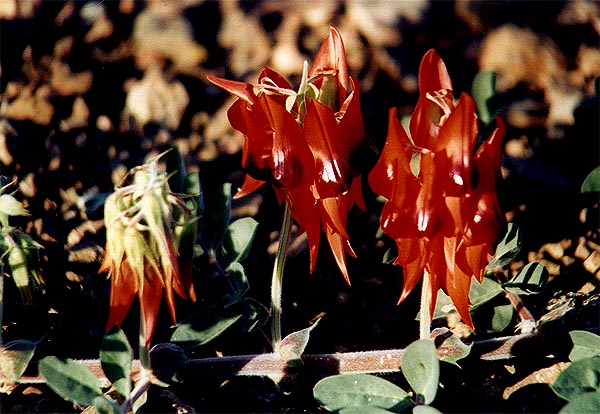
Sturt's Desert Pea
We stopped at the Petermaier River in a small dirt side road at fifty kilometres for an early morning tea, and a short time later had covered fifty five kilometres in two hours. We maintained the twenty seven and a half kilometres per hour average right up until we reached the turn-off to Port Hedland at the seventy kilometre mark, where we consulted an information board and decided to head for the Cooke Point caravan park. Our friend the wind then became a nasty adversary as we battled along at barely more than ten kilometres per hour.
At the Red Knoll bridge where the road rises to cross the railway lines, Karen and I stopped to take some photos of the nearby salt works. As we remounted, I warned Karen to watch out for the wind which was making progress difficult along the narrow pedestrian walk. Karen assured me that she would be careful - and promptly ran into the railing. Luckily, only her pride was hurt.
We set up at the caravan park then walked to the Boulevard Shopping Centre in town to buy some much needed food and supplies. In the evening after bussing back, we sat on a bench under a light from the caravan park office, drank cheap wine out of our plastic cups and congratulated ourselves on having survived the rigours of the Great Sandy Desert. We had crossed five hundred and seven nine kilometres of nothing, with only two roadhouses along the way. It had been a good preparation for the six hundred and forty kilometres of nothing with only three roadhouses along the way we would soon be facing between Karratha and Carnarvon.
In the meantime, however, we had the beauty of Port Hedland to savour.
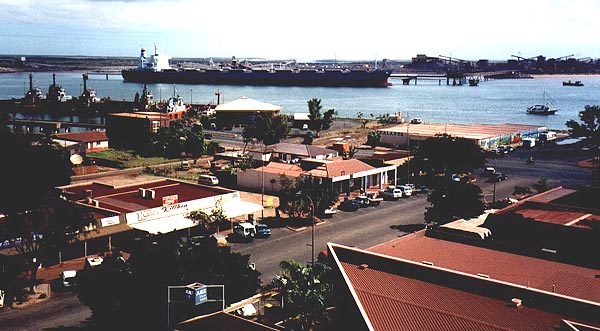
Port Hedland
|







